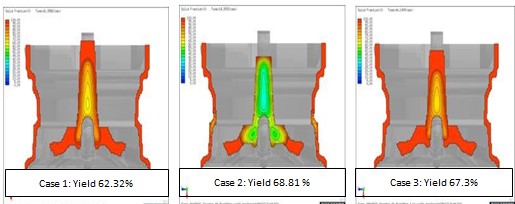What is Casting Yield?
Casting yield is a key performance metric in metal casting that measures how efficiently the molten metal is used to produce the final, usable casting. It is expressed as a percentage and is calculated as:
Importance of Casting Yield
- Cost efficiency: Higher yield reduces material waste and overall production cost.
- Energy savings: Less molten metal needs to be melted and handled.
- Process optimization: Indicates how well the gating and riser designs are optimized.
- Environmental impact: Lower metal waste means reduced recycling and energy use.
By using casting simulation, a designer can explore several un-conventional options and visualise the development of casting. By using casting simulation for gating optimisation, engineers can arrive at
- Where to keep the risers and runners? What is the best geometry (dimensions) of gates?
- What type of sleeves to be used? And how much MEF they will give? How the sleeves are beneficial for that particular product?
- What type of chills to be used and in which location?
- What is the optimum pouring temperature?
- How different types of sands will affect the casting?
- Where is the potential for turbulent melt flow and hence mold erosion?
By conducting casting simulation (for example by using ADSTEFAN software), it is possible to predict the casting defects; study the remedial measures to overcome the casting defects using casting simulation itself (without resorting to physical plant trial), and optimise the process.
How ADSTEFAN casting simulation helps for Yield improvement:
It assist engineers for optimum gating design. Below is one of case study demonstrating effectiveness of Yield improvement in GDC casting
We have considered an Alloy wheel casting of A356 material which is produced through gravity die casting (GDC) process.
Weight of Alloy wheel is 13 Kgs and along with initial gating design, Bunch weight of casting is 20.86 Kgs with Yield 62.32 %.
From below table - From results shown in below figure considering factor of safety Case 3 is best Methoding design and yield improvement for Alloy wheel component is optimized from 62.32% to 67.3 % saving raw material utilization and energy cost.
| Case | Casting Weight in Kgs | Bunch Weight in Kgs | Yield % | Remarks | Observation |
|---|---|---|---|---|---|
| Case 1 | 13 | 20.86 | 62.32 | Riser size of Dia= 72 mm and Height= 193 mm | Over feeding of riser is observed |
| Case 2 | 13 | 18.89 | 68.81 | Riser Weight reduced by 25% (Height reduced to 163 mm) from Case 1 | Underfeeding of riser and will lead to shrinkage in hub area |
| Case 3 | 13 | 19.29 | 67.3 | Riser Weight reduced by 20% (Height reduced to 168 mm) from Case 1 | Optimized riser feeding observed with improvement in Yield and defect free casting |



